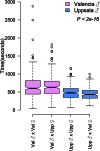Gene expression clines reveal local adaptation and associated trade-offs at a continental scale
- PMID: 27599812
- PMCID: PMC5013434
- DOI: 10.1038/srep32975
Gene expression clines reveal local adaptation and associated trade-offs at a continental scale
Abstract
Local adaptation, where fitness in one environment comes at a cost in another, should lead to spatial variation in trade-offs between life history traits and may be critical for population persistence. Recent studies have sought genomic signals of local adaptation, but often have been limited to laboratory populations representing two environmentally different locations of a species' distribution. We measured gene expression, as a proxy for fitness, in males of Drosophila subobscura, occupying a 20° latitudinal and 11 °C thermal range. Uniquely, we sampled six populations and studied both common garden and semi-natural responses to identify signals of local adaptation. We found contrasting patterns of investment: transcripts with expression positively correlated to latitude were enriched for metabolic processes, expressed across all tissues whereas negatively correlated transcripts were enriched for reproductive processes, expressed primarily in testes. When using only the end populations, to compare our results to previous studies, we found that locally adaptive patterns were obscured. While phenotypic trade-offs between metabolic and reproductive functions across widespread species are well-known, our results identify underlying genetic and tissue responses at a continental scale that may be responsible for this. This may contribute to understanding population persistence under environmental change.
Conflict of interest statement
The authors declare no competing financial interests.
Figures



Similar articles
-
Genetic trade-offs underlie divergent life history strategies for local adaptation in white clover.Mol Ecol. 2022 Jul;31(14):3742-3760. doi: 10.1111/mec.16180. Epub 2021 Oct 3. Mol Ecol. 2022. PMID: 34532899
-
QTL mapping of freezing tolerance: links to fitness and adaptive trade-offs.Mol Ecol. 2014 Sep;23(17):4304-15. doi: 10.1111/mec.12862. Epub 2014 Aug 12. Mol Ecol. 2014. PMID: 25039860
-
Patterns of geographic variation of thermal adapted candidate genes in Drosophila subobscura sex chromosome arrangements.BMC Evol Biol. 2018 Apr 24;18(1):60. doi: 10.1186/s12862-018-1178-1. BMC Evol Biol. 2018. PMID: 29699488 Free PMC article.
-
A critical review of adaptive genetic variation in Atlantic salmon: implications for conservation.Biol Rev Camb Philos Soc. 2007 May;82(2):173-211. doi: 10.1111/j.1469-185X.2006.00004.x. Biol Rev Camb Philos Soc. 2007. PMID: 17437557 Review.
-
The emergence of performance trade-offs during local adaptation: insights from experimental evolution.Mol Ecol. 2017 Apr;26(7):1720-1733. doi: 10.1111/mec.13979. Epub 2017 Jan 13. Mol Ecol. 2017. PMID: 28029196 Review.
Cited by
-
Elevated temperatures have sex-specific effects on nuptial gift behavior.Behav Ecol. 2025 May 8;36(4):araf049. doi: 10.1093/beheco/araf049. eCollection 2025 Jul-Aug. Behav Ecol. 2025. PMID: 40453416 Free PMC article.
-
A simple genetic basis of adaptation to a novel thermal environment results in complex metabolic rewiring in Drosophila.Genome Biol. 2018 Aug 20;19(1):119. doi: 10.1186/s13059-018-1503-4. Genome Biol. 2018. PMID: 30122150 Free PMC article.
-
Parallel gene expression evolution in natural and laboratory evolved populations.Mol Ecol. 2021 Feb;30(4):884-894. doi: 10.1111/mec.15649. Epub 2020 Oct 12. Mol Ecol. 2021. PMID: 32979867 Free PMC article.
-
Metabolic differentiation of brushtail possum populations resistant and susceptible to plant toxins revealed via differential gene expression.J Comp Physiol B. 2025 Feb;195(1):103-121. doi: 10.1007/s00360-024-01591-z. Epub 2024 Nov 4. J Comp Physiol B. 2025. PMID: 39495241 Free PMC article.
-
Population differences in Chinook salmon (Oncorhynchus tshawytscha) DNA methylation: Genetic drift and environmental factors.Ecol Evol. 2021 May 1;11(11):6846-6861. doi: 10.1002/ece3.7531. eCollection 2021 Jun. Ecol Evol. 2021. PMID: 34141260 Free PMC article.
References
-
- Savolainen O., Lascoux M. & Merila J. Ecological genomics of local adaptation. Nat Rev Genet. 14, 807–820 (2013). - PubMed
-
- Angilletta M. J. Thermal Adaptation (Oxford University Press 2009).
-
- Flatt T. & Heyland A (eds). Mechanisms of Life History Evolution: The Genetics and Physiology of Life History Traits and Trade-Offs (Oxford University Press 2011).
-
- Hilborn R. & Stearns S. C. On inference in ecology and evolutionary biology: the problem of multiple causes. Acta Biotheor. 31, 145–164 (1982). - PubMed
-
- Schmidt P. S., Matzkin L., Ippolito M. & Eanes W. F. Geographic variation in diapause incidence, life-history traits, and climatic adaptation in Drosophila melanogaster. Evolution 59, 1721–1732 (2005). - PubMed
Publication types
MeSH terms
Substances
LinkOut - more resources
Full Text Sources
Other Literature Sources
Molecular Biology Databases

